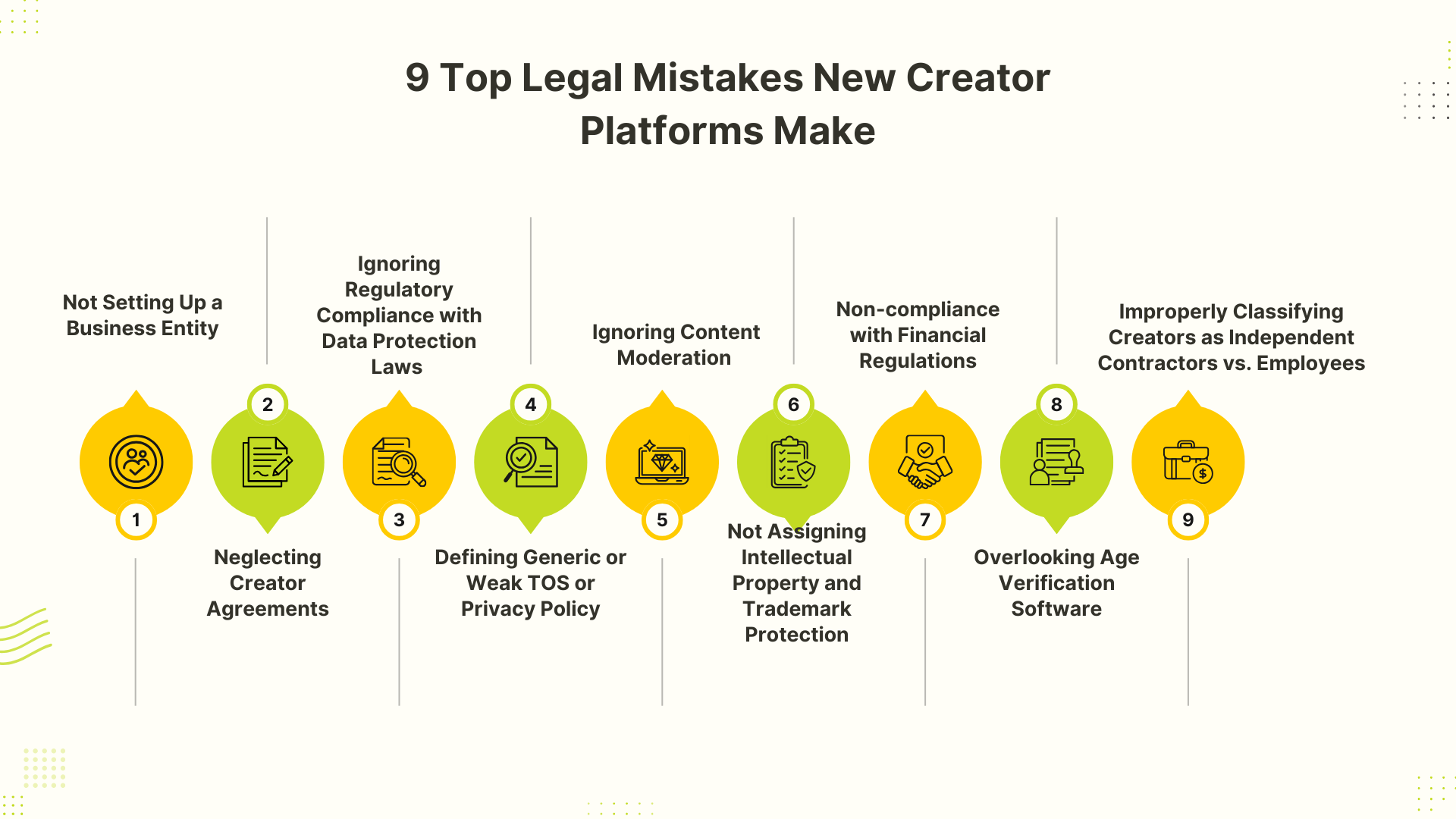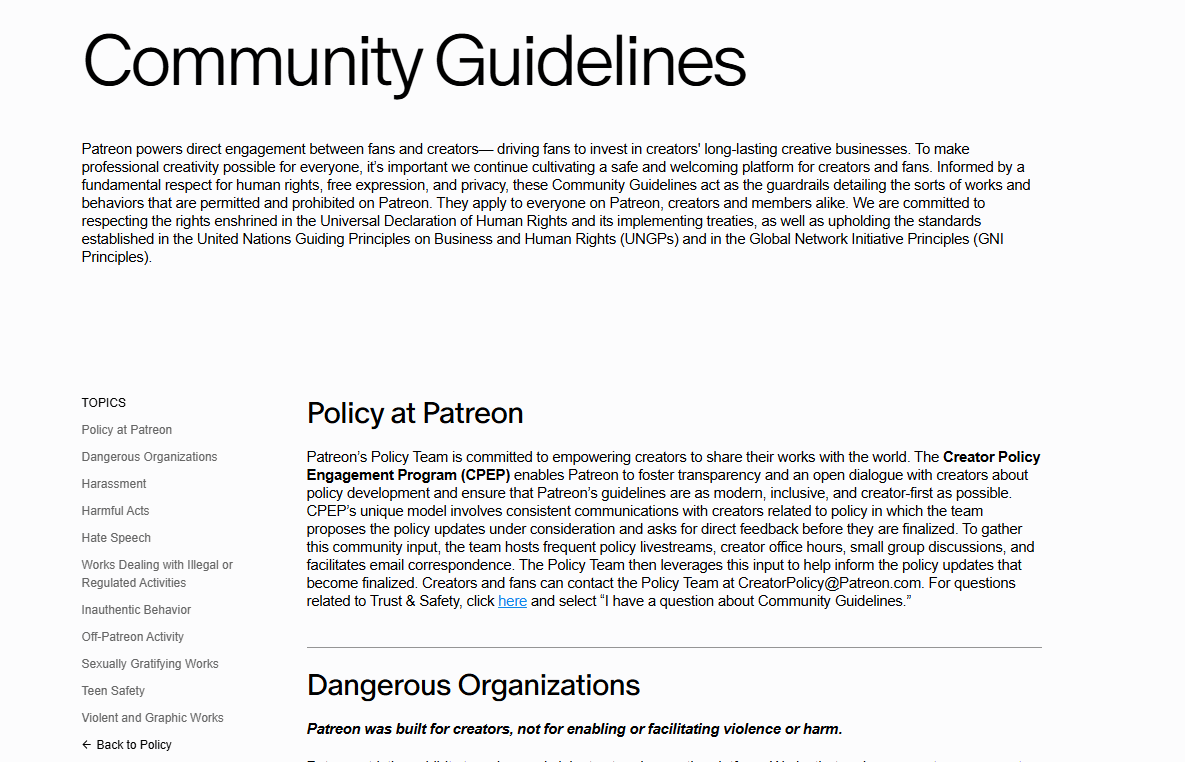Building a creator platform is an extensive process. From the aha business idea to actually kickstarting the development, it needs a lot of work. While most entrepreneurs concentrate on the product, the legal side is often an afterthought.
Neglecting legal compliance often leaves entrepreneurs in lawsuits or causes problems raising funding.
Besides, navigating the legal landscape is often challenging. The laws and regulations change across borders and diverse regions.
In this blog, we explore the most common legal mistakes new creator platforms make. If you’re building a creator platform or planning to build one, this guide will help you!
So, let’s navigate through the legal mistakes to avoid while setting up your creator platform!
9 Common Legal Mistakes New Creator Platforms Make
If you’re starting a creator platform, legal mistakes can trip you up. Navigating the legal landscape is challenging. To make it more complex, the legal procedures and compliance vary across states and countries.
From regulatory compliance to tax implications, creator platforms endure different legal battles.
Here are the common legal mistakes that creator platforms make:

Mistake 1: Not Setting Up a Business Entity
One of the most common mistakes creator platforms make is setting up a business without a proper business structure. A solid business structure, such as a sole proprietorship, LLC, or corporation, offers protection.
Why is it important?
Choosing the right business entity influences different aspects of your business. From registration to profits and legal protection, it defines your growth narrative!
With a formal entity, you can draw a clear boundary between business and personal assets. That’s called liability protection.
For example, if you choose LLC for your creator platform, it’s like a shield of armour. Suppose your business faces a lawsuit, you don’t need to compromise your personal assets. But if you choose to be a sole proprietor, there’s no clear barrier between personal and business income.
Another winning edge is tax flexibility. LLCs are known as “pass-through entities” and save platforms from double taxation. If you choose to be an LLC, you choose how to be taxed. Either as a single-member LLC or corporation.
Credibility and transfer of ownership are other upsides of having a proper business entity.
How to avoid it?
- Ensure your business structure aligns with the platform’s goals and objectives
- Consider factors like taxes, liability protection, compliance, etc.
- Pick the right business structure from the start for a successful stride
- Seek legal advice before setting up your business
Mistake 2: Neglecting Creator Agreements
People often misunderstand TOS with creator agreements. But, both contracts are different.
While terms of service are for all the users, creator agreements are especially for creators. The audience, scope, and purpose of both the legal contracts vary. So, plan to draft both the contracts. Cover the general terms in the TOS and keep the complex ones for creator agreements.
Why is it important?
Creator agreements are non-negotiable. After all, landing in an unprecedented dispute is the last thing you would ever want! This can negatively impact the creator’s working relationship with the platform.
A creator agreement clearly outlines the duties and responsibilities of both parties.
Essentially, it covers the following aspects:
- Ownership and IPR
- Payment Terms or Revenue Splits
- Duration Agreement
- Termination clauses
- Content guidelines and licensing
How to avoid it?
- Create a standard creator agreement to avoid ambiguity and legal risk
- Add the creator agreement for onboarding
- Ensure your agreement is jargon-free and easy to understand
- Designate a dedicated team for creator agreement compliance
Mistake 3: Ignoring Regulatory Compliance with Data Protection Laws (GDPR, CCPA)
Creator platforms host valuable consumer data. And the privacy and security of your data are pivotal.
Platforms often collect data without proper user consent. Data protection laws like GDPR and CCPA cover aspects like data collection, minimization, and consumer rights awareness.
Why is it important?
GDPR law is applicable to businesses and those providing services in the EU. Another essential privacy law is the CCPA (California Consumer Privacy Act). It includes the right to know what data is collected, how it’s used, opt-out and modification rights.
To sum up, here’s why adhering to data protection laws is important:
- Build trust and credibility
- Preventing data breaches and misuse
- More control and ownership over personal data
- Easy cancellations and refunds
- Prevents subscription fraud and attacks
- Non-adherence can lead to lawsuits, platform takedowns and loss of credibility
How to avoid it?
- Identify the data protection laws and regulations applicable to your region
- Add age gates and parental controls to your platform design
- Create a clear Terms of Service (TOS), privacy policy, and creator agreement
- Review your platform and perform an audit on a regular basis
- Train internal teams and creators on the compliance policies
Mistake 4: Defining Generic or Weak TOS or Privacy Policy
Your terms of service are not a mere set of rules and regulations for legal adherence. It‘s your failsafe proof — that protects your business, defines monetization and user rights.
Why is it important?
Businesses often use generic or outdated terms of service. This doesn’t even align with the platform-specific features. Moreover, it confuses the users and creates a vague picture of how they must act in a specific situation.
A poor TOS can also lead to non-compliance with regulations. That said, the data protection laws vary across different countries and regions. So, you can’t just blindly mimic someone else’s TOS or privacy policy.
A clear grasp of your audience is essential to crafting a TOS that resonates with them. Besides, it ensures you don’t force non-essential terms.
When you clearly list out all important terms in the TOS, you minimize user disputes.
How to avoid it?
- Draft a customized TOS and privacy policy based on your business needs
- Include age restrictions and clickwrap agreements involving user consent
- Clearly define what’s allowed and what’s not allowed on the platform
- Include who owns the content and what content is prohibited on your platform
- Cover all the aspects of payment in the TOS (schedule, thresholds, and methods)
- Link your TOS to the creator agreement and payment policy
- State the termination clause where the platform or user can cease the agreement
Mistake 5: Ignoring Content Moderation
As a platform owner, it’s essential to build a safe and positive environment for users. Creator platforms often host restrictive content involving violence, hate speech, or illegal activities. Such harmful content is often inappropriate for minors and causes a negative impact.
However, while exercising freedom of expression, you shouldn’t violate community guidelines. Content moderation is all about balancing freedom of expression with appropriate content. Text, images, and video content often need to be moderated.
Here are different videos that might need content moderation:
- Videos involving fights, violence, or hate speech
- Photos or videos involving explicit or adult content inappropriate for all ages
- Images or videos including copyrighted content
Rely on human-moderated + automated moderation to yield better results.
Why is it important?
Content moderation is crucial for creator platforms for the following reasons:
- Protect users from harmful, illegal, or violent content
- Comply with regulations involving DMCA, hate speech laws, and child safety laws
- To build trust and credibility around your brand
- Improve your content quality and drive traffic
How to avoid it?
- Allow users to flag or report offensive, infringed, and impersonated content.
- Create a prohibited content list including nudity, hate speech, violence and illegal use
- Define a robust appeal process for moderated content decisions
- Build a compliant tracking system where users can raise complaints
- Establish a clear content guideline policy for fair evaluation of content

Mistake 6: Not Assigning Intellectual Property and Trademark Protection
IP ownership is one of the concerning issues for the creator platform. From joint ownership disputes for content collaboration to unauthorized content access, these disputes demand content ownership.
In creator platforms, typically, creators own their content. And platform policies often define ownership and licensing terms of user content. This nips legal disputes in the bud and also ensures legal compliance.
Your brand identity is built on your names, logos, and taglines. So, while you spend hours designing your brand logo, your competitors flaunt a similar design on their website. And the worst thing is you cannot do anything about it!
That’s when IP ownership helps.
Another aspect to consider here is licensing any third-party content. This could be open-source libraries, external APIs, or stock images or fonts.
Why is it important?
IP ownership and trademark protection are crucial for businesses because:
- Protects your original platform content from unauthorized use
- Trademark protection, like licensing, drives revenue inflow
- Effective defense against infringement and makes takedowns easier
- Contributes to overall business value and growth
How to avoid it?
Here’s a quick guide on how to protect your platform content:
| Content | IP/ Trademark Protection |
| Videos, images, text | Copyright |
| Brand name & logo | Trademark |
| UI/UX Design | Copyright |
| Tagline | Trademark |
| Guides, tutorials, emails | Copyright |
Lastly, mention IP ownership clearly in the creator agreement or TOS policy. Include the DMCA process and possible consequences of IP infringement.
Mistake 7: Non-compliance with Financial Regulations
Whether you’re creating a music marketplace or celebrity video shoutout platform, convenient payments are important.
In fact, payment compliance is one of the essential aspects for a creator-friendly platform. Your platform might monetize from subscriptions, digital products, or courses, you need a streamlined payment process.
Over the years, payment compliance has become essential and digital payments have made it non-negotiable.
Stripe, PayPal, and Authorize.Net are popular PSS-DSS-compliant payment processors.
Why is it important?
Compliance matters for the following reasons:
- Protect sensitive customer data
- To prevent fraud and identity theft
- Adhere to global and regional regulations
- Avoid hefty penalties and operational disruptions
- Build trust and credibility for your brand
How to avoid it?
- Use a secure payment processor like Stripe Connect, PayPal, MangoPay, etc.
- Know the compliance requirements specific to your region
- Implement solid KYC/AML checks to verify creators
- Automate W-9 and W-8 collection for your platform
- Use multi-currency payouts through a trusted payment processor
- Include payment terms, refund policies, and chargeback policies in legal policies
- Leverage tools like Address verification (AVS) and 3D Secure
Mistake 8: Overlooking Age Verification Software
Today, it’s more critical than ever to verify your user’s age, given the rise in harmful and illegal content.
Imagine a creator platform without a proper age verification system. Underage users can easily bypass the verification and access the platform. This is especially important for adult platforms or platforms with explicit content.
Ondato, Jumio, Sumsub, and Veriff are popular identity verification softwares. These softwares either verify users with document verification, biometric checks, or AI-powered age estimation. Some platforms even include multi-layered verification for a more robust security system.
Another important concern here is the ethical aspect. Age verification software often collects sensitive information. Some essential details are government ID, face scans, address, date of birth, etc. So, there’s always a concern about whether the privacy of the information is compromised.
Why is it important?
The benefits of age verification software include:
- Prioritize creator’s privacy and security
- Compliance with global privacy regulations
- Prevent minors or underage users from accessing inappropriate content
- Build trust and credibility around your creator platform
- Reduce identity theft and fraud on your platform
How to avoid it?
Here are few age verification best practices you can follow:
- Choose a third-party age verification system that’s SOC2-certified
- Include multi-layered verification: age-gates, ID or selfie check, third-party checks
- Implement fraud detection like liveliness check or facial recognition
- Prioritize easy and seamless workflows
- Ensure your system adheres with global privacy regulations like COPPA, GDPR
Mistake 9: Improperly Classifying Creators as Independent Contractors vs. Employees
One of the most common pitfalls of creator platforms is classifying creators as contractors instead of employees. However, the decision depends on factors like control, schedule, payment and other benefits.
In fact, the IRS and U.S. Department of Labor has strict laws on employee classification. And there are scenarios where creators work as employees for platforms.
The most important aspect is the degree of behavioral control of the platform over the creator. If you dictate the work dynamics, then you must classify them as employees. This involves things like how to work, when to work, and what kind of content creators make.
Why is it important?
Misclassifications costs you the following risks:
- Extra payment for overtime, projects, and other benefits
- Penalties for withholding the remuneration taxes
- Lawsuits filed by creators
How to avoid it?
- Assess classification based on exclusivity, control, payment, flexibility, etc.
- Allow creators decide the content and when to post; avoid dictating schedules or operation method
- Pay based on performance; avoid weekly or hourly wages
- Comply with local laws, such as AB5 law in California to avoid lawsuits
Wrapping Up
Setting up a creator platform requires several administrative procedures for ensuring a proper legal structure. From registering your business to meeting the tax requirements, there’s a lot that needs to be done.
You need to include essential terms like ownership, payment, termination clauses in the creator agreement and TOS. Research the global and local regulations to avoid any legal repercussions. If you exercise behavioural control over creators, then hire them as employees.
By incorporating above-mentioned legal steps, you can set up a strong legal foundation for your business!
FAQ-Related to Top Legal Mistakes New Creator Platforms Make
1. What are the most common legal mistakes creator platforms make?
Below are the common legal mistakes creator platforms make:
- Not choosing the right business entity
- Neglecting creator agreements
- Ignoring regulatory compliance with data protection laws
- Defining a weak or generic TOS/privacy policy
- Not assigning IP ownership and trademark protection
- Non-compliance with Financial Regulations
- Overlooking age verification software
- Improperly classifying independent contractors and employees
2. How do creator platforms handle content moderation?
Content moderation needs three essential aspects: technology, human intervention, and community guidelines. Scrutinize for restrictive content, involving violence, nudity, illegal substances. Also, assess the copyright ownership of the content.
3. What to include in the creator agreement?
IP ownership clauses, revenue-sharing terms, content takedown process, usage and termination guidelines are the key terms for creator agreements
4. How do terms of service and creator agreements differ?
While TOS covers the terms and conditions for all users, creator agreements are specific to creators. It outlines the rights and obligations for content creators using the platform.


